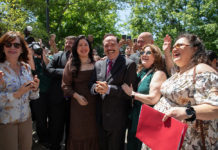Universal basic income was championed by Martin Luther King Jr., promoted by Silicon Valley citizens as the “social vaccine for the 21st century” and endorsed by 2016 presidential candidate Andrew Yang, but it has never really caught on.
Now its time may have come.
On Thursday California lawmakers approved the nation’s first state-funded guaranteed income program. Once the bill is signed by Gov. Gavin Newsom, cities and counties can apply for funding from a $35 million pool to support current or new pilots that prioritize foster youth who recently left the foster care system and pregnant mothers. The White House has also rolled out a form of guaranteed income in its new expanded Child Tax Credit that is part of the pandemic relief package.
The state program comes on the heels of local efforts in the Bay Area and Stockton. Over the last two years, Oakland, Marin County, San Francisco and Santa Clara County started one to two-year basic income programs that offer participants between $500 and $1,000 guaranteed dollars every month with no strings attached. Those programs are largely funded by private donations.
The surge in support for guaranteed income is being credited to the wealth and racial inequalities revealed by COVID-19, as job losses hit low-income and minority workers the hardest.
The pandemic “took the blinders off of what it means to live on the margins,” said Los Angeles county supervisor Holly Mitchell, a member of Mayors for Guaranteed Income, a national group that has grown from 11 member cities to over 50 in the last year. “Everyone saw it.”
The Bay Area basic income initiatives are focused on raising artists, mothers or minorities out of poverty. The Santa Clara County program, which helps foster youth, helped lay the groundwork for the statewide program.
“Cities are the laboratories of democracy,” said Sukhi Samra, director of the mayors’ group, who hopes the pilots in the Bay Area and across California will “provide a proof of concept” for federal policies.
The new wave of basic income initiatives is an alternative to government assistance programs that were “very prescriptive about doling out social services,” said state Sen. Dave Cortese, D-San Jose, who started Santa Clara County’s income program for foster youth as a county supervisor. “It really had a mentality of ‘we know what’s best for you weaker, poorer people.’”
Critics of guaranteed income worry that free money, similar to unemployment benefits, will discourage participants from working. “There’s a pretty plausible case to be made that the more generous you make unemployment benefits, the less anxious people are going to be to get back to work,” said Matt Zwolinski, director of the Center for Ethics, Economics and Public Policy at the University of San Diego.
Universal basic income supporters point to Stockton’s 2019 program, the first in the state, which found that full-time employment among participants increased by 12% in the program’s first year. Participants, who received $1,000 monthly from 2019 to 2021, reported greater financial stability month to month. That enabled them to buy the necessary food, pay off unexpected costs, and increase their overall wellbeing.
Zwolinski worries that the pilots’ one to two-year timeframes limit the evidence researchers can pull from the data.
“The pilot programs are worth doing. They provide some level of evidence,” he said, but “there’s always going to be a leap of faith involved in jumping from a pilot program to say a full city-wide program to a full statewide program.”
The City of Oakland’s new program is the largest in the Bay Area, offering $500 monthly to 600 families making below Oakland’s median household income, about $65,000 for a four-person family. San Francisco is offering $1,000 a month for 130 artists and 150 Black and Pacific Islander pregnant women. Similarly, Marin County will be supporting 135 low-income women of color with $1,000 monthly. Santa Clara County’s pilot program provides $1,000 a month to 72 foster youth. The programs either randomly select eligible residents or pull from an applicant pool.
One recipient of Santa Clara’s program was Veronica Vieyra, a recent San Jose State University graduate.
In March 2020, Vieyra was surviving on a $1,100 monthly stipend from an internship with iFoster, an organization supporting foster youth. Kicked out of the dorms as COVID-19 spread across California, her monthly expenses for rent, car insurance, and phone left her with $280 for food and gas. The 25-year-old’s grades plummeted and she fell into a new living routine.
“If I sleep I don’t have so much to worry about,” she remembered thinking. “I actually save money because then I won’t have to eat as much.” Vieyra planned to return to the job at Safeway she worked before college, delaying her graduation.
When Vieyra received her first payment at the end of the summer, “The first thing I felt was like, I’m going to pay my rent.” She paid two months ahead. “I was like, that feels so good.”
With greater free time, Vieyra attended after-hours tutoring for the classes she had failed the year before, graduating with a degree in public health. She hopes to work with foster youth.
“If it wasn’t for the program, I’d probably be going back to Safeway,” she said.
,
SoCoNews is partnering with CalMatters to provide a wider variety of news that gives our readers national and regional context for issues facing our local communities.











